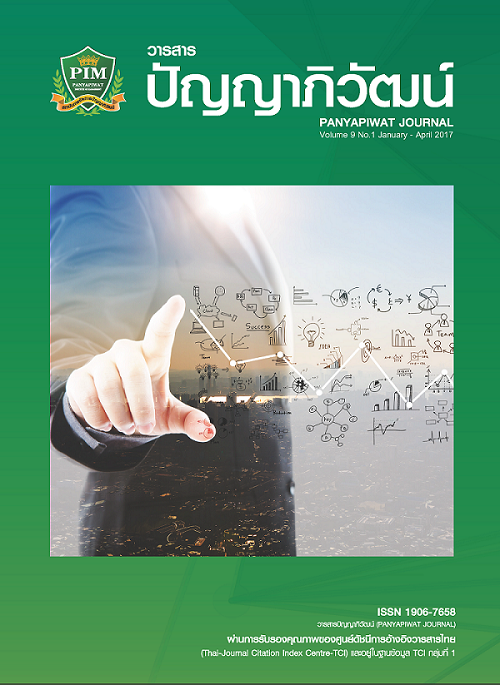ปัจจัยความสุขในการทำงานและความผูกพันต่อองค์กรที่มีผลต่อความพึงพอใจในการให้บริการของบุคลากรมหาวิทยาลัยต่างรุ่นอายุ
Main Article Content
Abstract
งานวิจัยนี้มีวัตถุประสงค์ 1) เพื่อศึกษาถึงปัจจัยความสุขในการทำงานและปัจจัยความผูกพันต่อองค์กรที่ส่งผลต่อความพึงพอใจในการให้บริการของบุคลากรมหาวิทยาลัยต่างรุ่นอายุ และ 2) เพื่อนำเสนอแนวทางการบริหารงานทางด้านทรัพยากรมนุษย์ที่จะก่อให้เกิดการพัฒนาที่เหมาะสมกับบุคลากรมหาวิทยาลัยในแต่ละรุ่นอายุ โดยเป็นการวิจัยแบบผสมผสานทั้งเชิงปริมาณและเชิงคุณภาพ ในเชิงปริมาณใช้แบบสอบถามทำการสำรวจแบบสำมะโนในบุคลากรของหน่วยงานแห่งหนึ่งในสังกัดมหาวิทยาลัยในกำกับของรัฐที่มีบทบาทและหน้าที่สำคัญในการให้บริการสื่อสารสนเทศและเอกสารทางวิชาการทั้งภายในระดับภายในและภายนอกมหาวิทยาลัย และในเชิงคุณภาพใช้วิธีการสัมภาษณ์เชิงลึกบุคลากรในสามรุ่นอายุ ได้แก่ Baby Boomer, Generation X และ Generation Y จากนั้นนำผลการวิจัยทั้งสองส่วนมาวิเคราะห์ร่วมกัน ผลการวิจัยพบว่า บุคลากรรุ่น Baby Boomer ปัจจัยความสุขในการทำงานสามารถใช้พยากรณ์ปัจจัยความพึงพอใจในการให้บริการ คือ หากบุคลากรรุ่น Baby Boomer มีความสุขเพิ่มขึ้น 1 หน่วย จะมีความพึงพอใจในการให้บริการเพิ่มขึ้น 0.620 หน่วย และบุคลากรรุ่น Generation Y พบว่า ปัจจัยความผูกพันต่อองค์กรสามารถใช้พยากรณ์ปัจจัยความพึงพอใจในการให้บริการ คือ หากบุคลากรรุ่น Generation Y มีความผูกพันต่อองค์กรเพิ่มขึ้น 1 หน่วย จะมีความพึงพอใจในการให้บริการเพิ่มขึ้น 1.128 หน่วย ในขณะที่รุ่น Generation X ไม่ปรากฎผลของปัจจัยทั้งสองที่สามารถใช้พยากรณ์ปัจจัยความพึงพอใจในการให้บริการ ดังสอดคล้องกับการศึกษาเชิงคุณภาพที่พบว่า รุ่น Generation X มุ่งเน้นความสำเร็จที่ผลงานเป็นสำคัญ โดยไม่ได้ตระหนักถึงปัจจัยความสุขในการทำงานและปัจจัยความผูกพันต่อองค์กร
The objectives of this research to 1) study the happiness in workplace and organization engagement factors affecting to satisfaction of services of difference generation of university staff, and 2) provide guidelines for the Human Resources Management to development of appropriate university staff in each generation. The research employed both quantitative and qualitative methodology. The quantitative used questionnaires to collect data as census in the one of the department of autonomous university. Where they are important role in providing academic media information, and academic papers both inside and outside the university. The qualitative used semi-structured interview, was employed in-depth interview in three generations including the Baby Boomer, the generation X, and the generation Y. The results of both methodologies were analyzed together, the results showed that in the Baby Boomer happiness in workplace factors able to predictive satisfaction of services. That is, if the Baby Boomer staff has happiness in workplace increase one unit, satisfaction of services will increase 0.620 units. Generation Y, organization engagement able to predictive satisfaction of services. That is, if the generation Y staff has organization engagement increase one unit, satisfaction of services will increase 1.128 units. While generation X does not appear as a result both of two factors that able to predictive satisfaction in services. Consistent with the qualitative study, generation X focused on performance and success of work are important, and not recognizing the happiness in workplace and organization engagement factors.
Article Details
I and co-author(s) certify that articles of this proposal had not yet been published and is not in the process of publication in journals or other published sources. I and co-author accept the rules of the manuscript consideration. Both agree that the editors have the right to consider and make recommendations to the appropriate source. With this rights offering articles that have been published to Panyapiwat Institute of Management. If there is a claim of copyright infringement on the part of the text or graphics that appear in the article. I and co-author(s) agree on sole responsibility.
References
Aon Hewitt Associates. (2014). Trends in Global Employee Engagement. Retrieved January 19, 2016, from http://www.aon.com/attachments/thoughtleadership/Trends_Global_Employee_Engagement_Final.pdf
Arkardjang, W. (2013). The Factors that Affect the Willingness of Talent in the Bureaucratic to Resignation. WMS Journal of Management, 2(2), 47-58. [in Thai]
Borchers, A. & Teahen, J. (2001). Organizational commitment of part-time and distance faculty.Retrieved February 22, 2016, from http://aisel.aisnet.org/cgi/viewcontent.cgi?article=1480&context=amcis2001
Chokthananukoon, B. et al. (2014). Happiness Watch Report, year 1 Round 2: July-December. Nakhon Pathom: Institute for Population and Social Research, Mahidol University. [in Thai]
Dechawattanapaisal, D. (2009). Recognition of Generation Y and Work Motivation: Views among Various Generation in Organization. Chulalongkorn Business Review, 31(121), 1-25. [in Thai]
Dobre, O. (2013). Employee motivation and organizational performance. Review of Applied Socio- Economic Research, 5(1), 53-60.
Ertas, N. (2015). Turnover Intentions and Work Motivations of Millennial Employees in Federal Service. Public Personnel Management, 44(3), 401-423.
Fisher, C. D. (2010). Happiness at work. Retrieved January 23, 2016, from http://epublications.bond.edu.au/cgi/viewcontent.cgi?article=1307&content=business-pubs
Kathryn, P. & Brodrick, V. (2009). The ‘What’, ‘Why’ and ‘How’ of Employee Well-Being: A New Model. Retrieved January 22, 2016, from http://link.springer.com/article/10.1007%2Fs11205-008-9270-3
Kittisuksatit, S. et al. (2012). HAPPINOMETER: The Happiness Self-Assessment. Nakhon Pathom: Institute for Population and Social Research, Mahidol University. [in Thai]
Kittisuksatit, S. et al. (2014). Quality of Life, Work and Happiness (2nd ed.). Nakhon Pathom: Institute for Population and Social Research, Mahidol University. [in Thai]
Kular, S., Gatenby, M., Rees, C., Soane, E. & Truss, K. (2008). Employee engagement: a literature review: Kingston Business School. Retrieved January 19, 2016, from http://eprints.kingston.ac.uk/4192/1/19wempen.pdf
Mazur, B. (2010). Cultural Diversity in Organisational Theory and Practice. Journal of Intercultural Management, 2(2), 5-15.
Millett, J. (1954). Management in Public Service. New York: McGraw-Hill Education.
Morrison, A. (1992). The New leaders: Guidelines on leadership diversity in America. San Francisco: Josey Bass.
Perry, J. L. & Wise, L. R. (1990). The Motivational Bases of Public Service. Retrieved January 19, 2016, from http://www.indiana.edu/~jlpweb/papers/The_Motivational_Bases_of_Public_Service_Perry_&_Wise%201990.pdf
Peter, W. (2007). Work, Happiness, and Unhappiness. New Jersey: Lawrence Erlbaum Associates.
Pitaktepsombati, P., Wattanasin, J. & Panyasiri, C. (2009). Job Satisfaction and Organization Engagement: Meaning, Theory, Research Methods, Measurement, and Research. Bangkok: Sematham. [in Thai]
Thongthai, V. (2009). American Society through Various Generation. In C. Phothisita & S. Thaweesit (Eds.). Population and Social 2009: “Thai Families in the Social and Demographic Transitions”.Nakhon Pathom: Institute for Population and Social Research, Mahidol University. [in Thai]
Wangphaicharoensuk, W. & Utsahajit, W. (2015). Creating and Promoting Work Happiness: A Case Study of Happy Workplace. Panyapiwat Journal, 7(3), 191-201. [in Thai]
Watthanarat, A. (2013). Transformational Leadership, Happy Management and Happiness at Work. Thesis of Human Resource and Organizational Development, National Institute of Development Administration. [in Thai]
Yodvisitsak, K. (2014). Gen-Y Building up Employee Engagement through Happy Workplace Concept in Gen-Y Employees. WMS Journal of Management, 3(2), 1-10. [in Thai]


